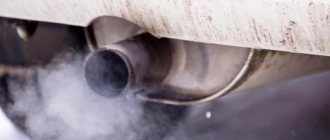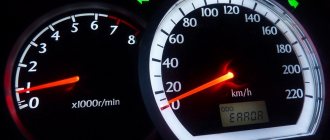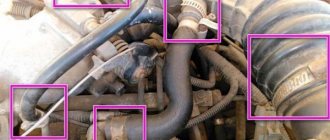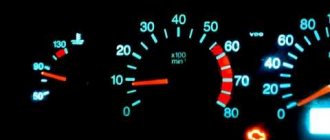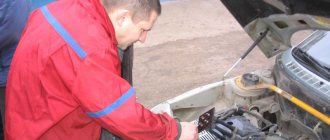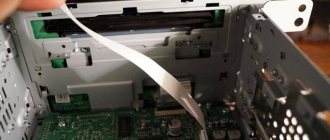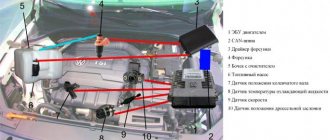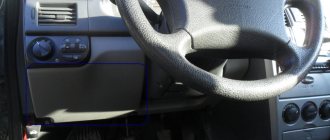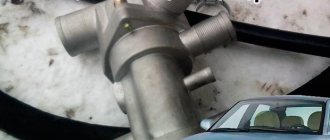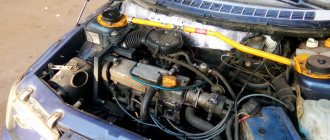It often happens that while driving the VAZ 2110 does not pick up speed well. Thus, driving at low speeds can greatly affect the comfort and safety of driving the car. This problem makes maneuvering and overtaking extremely difficult. That is why such a problem should be corrected immediately.
This problem, in which the VAZ 2110 is not gaining momentum, may have several reasons:
- Problems with air supply to the engine;
- Faulty ignition system;
- Faulty fuel supply system;
- Problems with the exhaust system.
Causes
There may be several reasons for the lack of proper speed gain:
- There are problems with the air supply;
- The ignition has failed;
- Fuel system malfunctions have occurred;
- There were problems with the exhaust system.
Fuel system problems are common in gasoline engines. They are the most common. Therefore, you should start with checking it.
Fuel system
If problems arise when accelerating the car, start checking by inspecting the fuel system.
- Most often, the engine stops gaining momentum because the fuel pump fails. At first, this may have a slight effect, sometimes unnoticed. Over time, as the pump wears out, the speed and power will begin to drop, and the acceleration dynamics will decrease.
- If the fuel pump is partially damaged, it still partially performs its functions, but is no longer capable of delivering the same volumes of fuel. This results in fuel starvation and power loss.
- The best solution to a problem with the pump is to replace it. It is better to trust repairs to specialists.
Ignition
If the ignition fails, you will have to conduct a comprehensive check of all system components that may cause a drop in engine power and speed.
What to check
Peculiarities
If the marks are installed incorrectly, fuel will not be injected in a timely manner, and the correct frequency of spark supply will be disrupted.
You will have to check all the sensors that take part in the operation of the ignition system. Pay special attention to the crankshaft and camshaft position sensors. A regular test allows you to quickly determine whether the sensors are really to blame
If the belt has been in use on your vehicle for a long time, it may be at the end of its service life. Or it was installed incorrectly when replacing it. After all, it is enough to make a mistake by one tooth, and the performance of the car will be impaired, the car will not be able to accelerate properly
In some cases, they do not allow the car to start at all if there is a malfunction, but sometimes they lead to a noticeable drop in power. Remove them, check their condition, clean them, measure the distance between the electrodes. If they fail, simply replace them with new ones.
To finally verify the presence or absence of problems in the ignition system, it is recommended to conduct more detailed diagnostics.
Diagnostics
We suggest you familiarize yourself with several steps aimed at diagnosing the condition of the ignition system. This may help determine why the engine is not revving up.
- Make sure that the electronic control unit is performing its functions. First of all, turn on the ignition and listen to whether the fuel pump starts working.
- Measure the pressure in the fuel line. If the readings fall within 2.5-3.0 kg/cm3, then everything is fine.
- If the measurement readings are normal, check the BitStop parameter using scan tools while cranking the crankshaft. If the parameter is indicated “no”, then the ECU receives the command to create a spark at the plugs and works well.
- Using a high-voltage spark gap, you can check for the presence of a spark. After all, it’s not uncommon for worn-out, dirty spark plugs to be to blame.
Air supply
It is not uncommon for engine thrust to deteriorate due to a disruption in the normal air supply to create the air-fuel mixture.
If there is more air, the mixture will be lean because the amount of oxygen will exceed the amount of fuel. Hence the drop in power and decrease in traction.
The easiest way to solve an air supply problem is to replace the air filter. In order to prevent and prevent problems from occurring, this element should be changed twice a year.
Checking the mass air flow sensor
If the engine speed increases, but the speed does not increase, there are several possible explanations for this phenomenon:
- The pressure in the fuel system is too low;
- The operation of the mass air flow sensor is disrupted. The sensor most often returns to its previous performance after cleaning. If it doesn't help, replace it;
- The air filter is clogged. It is better to replace it;
- The nozzle is clogged. This is mainly due to the low quality of the fuel you fill your car with.
If the diesel engine doesn't work
A decrease in traction can also occur in diesel engines. If we look at old cars that have completely mechanical power systems, then the most common cause is depressurization of the system.
As a result, air enters the fuel, which is why the fuel injection pump is unable to provide the required pressure.
Don't forget about:
- clogged filters;
- weakly pumping fuel priming pump;
- damaged plunger pair;
- Coking of injector nozzles.
And if we also add possible problems with the timing belt and CPG, then identifying the cause will not be so easy.
In modern diesel installations, where an additional electronic component is used, the search range will increase.
For example, the Common Rail system uses all the same sensors as the injection engine. And if at least one of them breaks, this will certainly affect the operation of the control part.
Posts 6
1 Topic by max_fil 2016-10-15 15:34:14
- max_fil
- Participant
- Inactive
- Registration: 2013-04-30
- Messages: 42 Thanks : 12
- Car: VAZ 21103
Topic: Resolved: VAZ 2110 8 valves fails and has no traction
Hello Tazavod. I came across this problem. 2110 8 valve injector. Doesn't want to go. It is gaining momentum very poorly, one might say it is not gaining momentum at all. Big failures. Choke or whatever you can call it. I replaced all possible sensors (crankshaft, idle speed, throttle, cleaned injectors, changed spark plugs, armored wires, fuel pump mesh). Nothing helped. Such a strange thing was noticed, under load, in neutral everything seemed to be normal. When driving, when a failure occurs, you press the gas pedal to the floor, it seems to be trying to go, then slowly releasing the gas, it gains momentum. Where to go, what to look for? PS. I didn't measure the compression.
2 Reply from Sergey VAZ 2111 2016-10-15 18:08:09
- Sergey VAZ 2111
- Connoisseur
- Inactive
- Registration: 2013-11-21
- Messages: 513 Thanks : 145
- Car: VAZ 2111
Re: Resolved: VAZ 2110 8 valves have dips and no traction
If this problem suddenly arises, it means there is no compression. You need to check the fuel pressure in the rail. Either the fine filter is clogged, or the pump is tricky, or the check valve is tricky.
3 Reply from anton_lapin_90 2016-10-16 15:46:45
- anton_lapin_90
- New member
- Inactive
- From: Sukhinichi
- Registration: 2016-10-16
- Messages: 1 Thanks : 0
- Car: VAZ 2110 8kl.
Re: Resolved: VAZ 2110 8 valves have dips and no traction
First, compression - the main thing is to eliminate the mechanics, and then timing marks, spark, fuel pressure, etc.
4 Reply from artem3107 2016-10-16 19:33:05
- artem3107
- New member
- Inactive
- Registration: 2016-10-10
- Messages: 12 Thanks : 1
- Car: VAZ 21102
Re: Resolved: VAZ 2110 8 valves have dips and no traction
Hello Tazavod. I came across this problem. 2110 8 valve injector. Doesn't want to go. It is gaining momentum very poorly, one might say it is not gaining momentum at all. Big failures. Choke or whatever you can call it. I replaced all possible sensors (crankshaft, idle speed, throttle, cleaned injectors, changed spark plugs, armored wires, fuel pump mesh). Nothing helped. Such a strange thing was noticed, under load, in neutral everything seemed to be normal. When driving, when a failure occurs, you press the gas pedal to the floor, it seems to be trying to go, then slowly releasing the gas, it gains momentum. Where to go, what to look for? PS. I didn't measure the compression.
It looks like the fuel pressure regulator is faulty.
Hello, Sergey. What does this have to do with the DPKV error? The ECU is not able to detect a rotated pulley. Error 335 can only appear if there is a malfunction of the sensor itself, its wires or the mass air flow sensor. This error also sometimes appears when jumping over a speed bump or other obstacle.
Hello, Sergey. What does this have to do with the DPKV error? The ECU is not able to detect a rotated pulley. Error 335 can only appear if there is a malfunction of the sensor itself, its wires or the mass air flow sensor. This error also sometimes appears when jumping over a speed bump or other obstacle.
Many car enthusiasts are faced with the concept that the 16-valve VAZ-2112 does not gain momentum well. There may be several reasons for this phenomenon, so you need to know how to identify the malfunction, and most importantly, how to fix it.
Write a Comment
Click to cancel reply.
All about 2109
How to remove and clean the injectors on a VAZ 2109 (injector)?
Contents: Location When replacement is required Removal and
Reasons for engine overheating on a VAZ 2109 (carburetor, injector)
It's no secret that the engine is the main unit of the entire car. Your ability to drive a car, consume the optimal amount of fuel, and more depends on its performance. But overheating is a very common situation in which many people make serious mistakes.
Repair of the exhaust manifold on a VAZ 2109 (carburetor)
The exhaust manifold is a component of the exhaust system that carries out the process of removing exhaust gases from the cylinders of the power unit into the exhaust pipe.
Everyone has something happen to their car at some point. So my VAZ-2110 periodically has problems. What can I say, she’s already old.
My 10-wheeler began to show increased revs. It seems like I let off the gas, but the revs remain high. Then they gradually decrease. Or it idles, everything seems to be fine, and then suddenly the revs increase and increase on their own.
Causes of poor speed gain
General view of the engine under the hood
So, let's look at what the problem is and where exactly you need to look for it:
- Fuel pump and pressure.
- Injectors.
- Fuel rail.
- Ignition system.
- Electronic control unit.
Now that all the causes are predetermined, you can begin sequential diagnosis and methods for solving the problem.
Options for solving the problem
To diagnose all of the above systems you will need a set of wrenches and screwdrivers, a tester, a little knowledge and hands growing from the right place. The main task remains to correctly distribute the sequence of operations. This is exactly what we will talk about next. So, let's look at where we need to go to remove the effect that has arisen.
Fuel pump, filter, rail and injectors
Fuel pump in the process of disassembly and diagnostics
First of all, for diagnostics it is necessary to diagnose the gasoline module (pump). If the car drives at high speeds, then everything is fine with the pump itself, but the problem may lie in the filter mesh . For inspection, you will have to remove the fuel pump and replace the cleaning screen on it, which is primarily responsible for purifying gasoline. Most likely, it is dirty and needs to be replaced.
General view of the fuel filter
The second problem may be the fuel filter, which needs to be replaced. It is often dirty and needs to be replaced. After the first two elements of the fuel system have been replaced, you can try to drive it and see if the problem goes away.
General view of the fuel rail with injectors
If, nevertheless, the car continues to gain momentum poorly, then you need to crawl under the hood and look for the problem directly in the fuel injection system. To do this, you need to measure the pressure in the fuel rail.
To do this, dismantle the fuel rail with injectors and disassemble the assembly. The first element must be checked for leaks. Injectors are often installed on a special stand, cleaned and diagnosed. If necessary, all damaged elements are replaced.
Ignition
Unscrewing the spark plugs from the engine
If the fuel system has been checked and is working properly, then you need to look for a problem in the ignition system. So, the high-voltage wires are dismantled and the spark plugs are unscrewed. Both elements are checked using a tester . Of course, it is best to diagnose spark plugs on a special spark plug stand. As practice shows, the problem in 50% of cases lies precisely in this unit, so after checking it is necessary to replace the damaged elements. We conducted a special survey on the choice of candles.
If all of the above reasons are eliminated and the components are working properly, then most likely the firmware has failed or a critical number of ECU errors have accumulated.
To eliminate the cause, you need to connect the laptop to the engine control unit and carry out diagnostics.
As practice shows, the problem is generally resolved by replacing the software. Instead of standard software, many motorists install Paulus products, although most simply reset the settings to factory settings.
Reading ECU errors using the instrument panel
Where to begin?
When you first have problems accelerating a car, you should start checking the car with the fuel system. The most common breakdown of a car's fuel system is the fuel pump, and it makes no difference whether it is mechanical or electrical. Both the first and the second are equally likely to fail at the most inopportune moment.
Difficulties with the pump may appear after a while. The car can slowly reduce its speed characteristics, and when this process reaches a noticeable state, you will understand why the engine does not gain speed.
The problem is the fuel pump, which, although it has not yet failed, is no longer actively supplying fuel to the engine. This inevitably leads to fuel starvation of the car, and, as a result, loss of power.
- You should start checking the ignition with the timing marks. It is the correctness of their installation that determines how timely fuel injection and spark supply will be.
- If the marks are in order, you should pay attention to the numerous sensors, which are plenty for an injection engine. You can check the crankshaft position sensors, camshaft position sensors and others yourself or entrust the car to a specialist.
- If everything is fine here, it’s worth paying attention to when the timing belt or chain was changed. The reason why your VAZ does not gain speed may be due to incorrect installation of the belt. Here it is enough to make a mistake by one tooth, and you can safely forget about normal acceleration of the car.
The 406 engine may not gain speed due to the fault of the injector, and the problem will be divided into two:
- the car won't start at all;
- the car does not work properly (this includes problems with speed, both while driving and idling, as well as all kinds of jerking of the car).
In the first case, the “nine” is often helped by warming up the battery or even recharging it. As you might guess, this situation occurs in winter during frosts. The reason lies in the decrease in battery capacity, which may simply not be enough to start the engine.
The second way to revive a frozen car is to supply hot air through a hair dryer. This “folk” method also helps many.
And finally, the third reason why a car may not start is faulty spark plugs.
Methods for diagnosing the problem
For the most accurate diagnosis, you will need to use a diagnostic tester, a fuel rail pressure gauge, a vacuum gauge and a spark gap.
- The first thing to check is whether the engine is controlled by the ECU. To do this, simply turn on the ignition and listen to whether the fuel pump makes noise.
- Then we look at the fuel line pressure. Data at the level of 2.5 - 3.0 kg/cubic centimeter are considered the norm.
- If these parameters are normal, you can check the BITSTOP parameter using the diagnostic tools while cranking the crankshaft. The BITSTOP parameter must be set to "no". This indicates that the ECU receives a command to start forming a spark on the spark plugs and is fully operational.
- By connecting a high-voltage spark gap, you can check whether there is a spark at all, and perhaps the cause is poor-quality spark plugs.
Also find out how much oil to fill in the engine and about flushing the engine before changing the oil.
Air supply
The air supply can also cause poor vehicle traction. If more air enters than it should, the composition of the fuel mixture will be disrupted. Those. there will be more air and less fuel, which will lead to a drop in thrust.
The simplest solution is to replace the air filter, which is recommended to be done every six months.
If the engine speed increases, but the speed does not gain, the reasons may be:
- low pressure in the fuel system (as mentioned earlier);
- problems in the operation of the mass air flow sensor;
- air filter clogged;
- coked nozzle.
It is more difficult to understand the operation of the mass flow sensor, since each car must have its own parameters, and you will still need the appropriate equipment. Even a deviation from the norm of 3 kg/hour can cause significant “changes” in engine operation, and not for the better.
Using the 406 engine as an example, we can say that the norm is 13 - 15 kg/hour. At the same time, reducing the flow to 11 kg/hour will lead to such a problem that the engine does not gain speed or does so slowly, while increasing this figure to 19 kg/hour will significantly increase fuel consumption, and this is also unpleasant.
Coking of injectors is most often the result of low-quality fuel, since problems with the “electrical” part arise extremely rarely. To check, they often turn off the injectors one by one, while monitoring the drop in engine power. The norm is approximately 110 revolutions.
However, such diagnostics are labor-intensive and will not give a 100% result, so all owners of injection systems, including 3sfe, are not recommended to clean their injectors every year. Who knows, maybe your 3sfe engine does not gain momentum for this very reason?
Various jerks and dips during engine operation are another side of the TPS or mass air flow sensor malfunction. In this case, it is also difficult to diagnose TPS problems, and in addition to the equipment, you will need to clearly know at what crankshaft speeds failures occur, such as jerks or power failures.
Car exhaust problems
Before you start considering this issue, it is worth checking your car's catalyst. If it is still there, you should make sure it is not clogged. Even with the car’s impressive characteristics, trying to “squeeze” an acceptable speed out of it at high engine speeds will simply not be successful. Here lies the answer to the question, why install mufflers of larger diameter on cars? Precisely to increase power, since the absence of a muffler can add up to 15% power to a car.
see also
“Peter - AT” INN 780703320484 OGRNIP 313784720500453
Up to 3 thousand revolutions it works like a clock, but after that it starts to jerk a lot! The fuel pump, armored lines and ignition unit are new! What could it be? (VAZ injection, 8 valve)
Comments 47
hose for the vacuum tank, how is it doing intact or with holes, look
good idea, thanks)
please ask the author of the topic to share with others how he solved the problem
so I shared it seems that 2 injectors were clogged, and since I was not there I don’t remember which ones (by count), they replaced the injectors and everything became fire)))
then sorry, I must have missed it
This also happened, it turned out that the fuel filter at the bottom was clogged, could not stand it and all the debris got into the injectors, at first it jerked, and then completely stalled. But after it started twitching, I drove another 300 km. Upon arrival home, I changed the filter, cleaned the tank and injectors and forgot about it.
replace the filter that is under the bottom of the car and drive on
How many people, so many opinions. Look at all engine systems one by one from simple to simple. If the check light does not light up, then it is unlikely to be a camshaft sensor, and it does not look like it. Also, if the crankshaft sensor doesn’t work, you won’t start the car. Look at the crankshaft pulley, it was somehow loose, just at speed it got into resonance and the DPKV could not get a normal signal from it. Relevant if you recently climbed into the timing belt. Check the air and pressure in the rail.
Look at the oxygen flow sensor)
Look at the crankshaft pulley, sometimes it even turns the crankshaft gear, look at the synchronization, it will show everything
+100. The key was cut off and the mark moved a little. That’s where the adjustment and lack of speed come from.
I have a piece of paper stuck to the filter in the tank... how the hell it got there, who knows. After 3.5t the car stalled while driving. at idle everything was ok
199% change the DMVR (Preferably BOSCH) in the air intake I had the same thing on a VAZ 21102, changed it and forgot.
Doesn't it stall if you raise the rpm to 4 thousand and hold it?
By the way, the same thing happened to me at ten. I cleaned the ramp and injectors at the same time. and the car flew off
go for diagnostics, what are you thinking... otherwise you will waste extra time, extra money on extra spare parts...
A new pump does not mean it is working, measure the pressure. The sensors most likely have nothing to do with it; they would work in emergency mode if they fail. what fuel system? with return? Look at the pressure reducing valve, and in general measure the pressure in the fuel rail.
Jerks when cold
Many owners of the VAZ 2110 note that jerks occur when cold, and after warming up, the car gets into a rhythm while driving and stops “sausaging”. The main reason in this case is called a lean mixture, due to the fact that air is sucked in at idle. Or one of the sensors “died”.
If dips often occur when cold (as well as when driving), in addition to everything already listed, you need to check:
- spark plugs - if they have heavy carbon deposits, and even make poor contact with the wires, this needs to be corrected urgently. In the first case - by replacement, in the second, by cleaning and strengthening contacts;
- high voltage wires . Checked with an ohmmeter (multimeter). But if they even look old and shabby, it’s better to just replace them all at once;
- ignition coil . You need to check the armored wires and the ignition module while wearing rubber gloves, otherwise you may get a slight electric shock if there is a break;
- The timing belt can jump a couple of teeth, then when cold there may well be failures. Therefore, check whether the marks on the pulleys match. If not, the belt must be removed and set correctly;
- be sure to check the oxygen sensors (OS); mass air flow (MAF); idle air regulator (IAC), if a malfunction is detected, replace them;
- filters . In principle, they need to be checked first, even before serious damage occurs. Air and fuel filters are designed to give cars a clean mixture. That is, they take on all the debris particles, so they become clogged, worsening the dynamics of the car, and also increasing fuel consumption. They need to be changed regularly.
IF YOU HAVE CHECKED EVERYTHING, TRIED TO FIX IT, BUT NOTHING HELPS, YOU SHOULD ONLY SEEK THE REASON IN THE ENGINE ITSELF.
It is possible that the fuel injectors in a fuel-injected vehicle are clogged. Then you will need professional diagnostics in the service.
You should not miss one more point, because of which, when cold, as well as when driving, metamorphoses such as twitching can occur with the car: did you put the right gasoline in it? Advice to all car enthusiasts is always relevant: if possible, refuel at a reliable, proven gas station. Low-quality fuel can not only cause jerking, but also damage not only the fuel pump, but the entire engine.
General concepts
One of the most common troubles that prevents you from fully driving a car is the idle speed sensor of the VAZ 2110 and modifications. Although this device is called a sensor among drivers, it will still be correctly called the idle speed controller, abbreviated as IAC, because all automobile sensors are measuring equipment, and this product serves to automatically stabilize and maintain idle speed by supplying air to the engine VAZ 2110 with the throttle valve fully closed.
IAC is an important component of the engine and plays a significant role in the stable and uninterrupted operation of any VAZ vehicle.
Idle speed control
The VAZ 2110 idle speed sensor (abbreviated DXX) is an actuator, simply a valve consisting of an electric motor, a spring, and a rod on which a shut-off needle is installed (you can see it in the photo). It is through which the volume of air is dosed. That is, when the throttle of a VAZ 2110, 2112 is completely closed, and the controller determines that the idle speed needs to be increased, the IAC generates a command to change the position of the needle. It moves, partially or completely opening the intake port, through which air bypasses the throttle and then mixes with fuel. As a result, the engine does not stall.
conclusions
Determining and eliminating the causes of poor speed of the 16-valve VAZ-2112 engine is quite a difficult matter. It is necessary to go through each node step by step, which may be the cause of the malfunction. Well, if the motorist was unable to diagnose the problem on his own, then it is recommended to contact a car service center, where specialists will quickly determine what the problem is and fix it.
Guys, tell me, well, in short, I washed the injectors and installed the ramp. Then, for various reasons, I had to remove the ramp 10 times. Then there was a problem with gas. When you press the pedal lightly (at any speed and at any rpm), the car behaves calmly. When you sharply press the pedal to the floor (well, when overtaking or in competitions), you feel like the car is sort of choking on gasoline. It seems to stop accelerating as expected. And the harder you press, the more stupidly the car clamps. Consumption has also increased. I filled the amplifier into the tank, the car seemed to come to life, but sometimes I felt jolts when I pressed the pedal for the first time.
While operating their car, many drivers begin to notice that the engine does not gain speed properly. Accordingly, the dynamics decrease, the possibilities of maneuvering and overtaking are reduced. This problem cannot be tolerated.
The engine does not pick up speed VAZ 2110 injector 8 valves. It's gaining momentum very poorly
1) Greetings, Happy New Year. car VAZ 2114, engine 1.6 8 valves. I don’t understand where to dig, it picks up speed very poorly, the slipper is on the floor, but it doesn’t react, then it picks up slowly, and you squeeze the clutch, it may either stall or it will idle at 520-630 revolutions and the sound is like the Cossacks, like a pot doesn't work, Jackie Chan doesn't burn. Tell me where to start digging Question from: @id1822769 Separate topic: 2) guys, such a story! VAZ 21074. The eight-wheel carburetor has an idle speed solenoid valve on it! So I decided to change it because the revolutions began to jump! a wire is connected to the solenoid valve, so that’s the rub, I remembered the valve, the speed also jumps, and now in addition to this, when the wire is disconnected from the valve, the car continues to work at very low speeds, but it works! ps before, when the wire was disconnected, the engine immediately stalled. Well, who can advise or help))) (I’ll tell you right away, I’ve already changed 3 of these valves, the result is the same) Question from: @id183726641 Separate topic: Write the number of the question you’re answering! To the authors of questions: be sure to write in the comments how you solved your problem! The engine does not pick up speed VAZ 2110 injector 8 valves.
While driving
It is also an unpleasant situation when the car has jerks and dips during acceleration. This can happen both when driving and when starting off. A particularly unpleasant, or even dangerous, situation can arise while driving, for example, when a car is about to overtake, and then there is a sudden failure.
The causes of jerks during acceleration can be both those already mentioned and slightly different ones:
- If you have a carbureted car that jerks when accelerating, this may indicate that the ignition is too early. You need to set the lead angle. And checking the ignition timing is quite simple: at speed 4, accelerate to 50 km/h and brake sharply. If detonation lasts 1-2 seconds, then the ignition is set perfectly, the reason is not there;
- on “injectors” everything is controlled electronically. There, the jerking while driving and during acceleration may be due to the mixture being too lean. But this should be shown by diagnostics in the service. If the sensors “know about this, but are silent,” then it is quite possible that they themselves are faulty and must be replaced.
Faulty fuel supply system
One of the common reasons for poor engine speed may be the slow failure of the fuel pump. At first, this problem will not be very noticeable. But in the future the problem will become more and more noticeable. Because the pump will pump fuel into the engine worse and worse, which, in turn, will drop in speed.
The most rational solution to this problem may be to replace the fuel pump with a new one.
Crankshaft sensor
Crankshaft sensor removed from the engine The crankshaft sensor can also cause the car to jerk. This effect was more common on the first models 2110-2112. Of course, in the second and subsequent generations this problem was eliminated.
The sensor gives the ECU contact information about the crankshaft speed, but if it breaks down, the data gets stuck in the last information provided. If you drop the speed from high to low, it turns out that the information has not reached the “brains”, but a lot of fuel is still supplied. Replacing the sensor solves this problem.
Solving the problem of deteriorating vehicle traction
ZMZ-409 engineZMZ 409 engine In any case, the problem of a drop in vehicle power cannot be ignored. Having made itself felt today, it will progress every day and cause more and more inconvenience and will ultimately damage the engine. Timely computer diagnostics and a thorough inspection of the machine by a qualified specialist will help you get rid of the problem.
Replacing spark plugs, high-voltage wires, and an air filter can, of course, be done on your own if the need arises. But if, after installing new parts, the behavior of your personal vehicle has not changed for the better, it is worth sending it for diagnostics to a specialized service, where experienced technicians will diagnose the cause of the deterioration in traction of your car.
Source
Pros of VAZ 2111
Spacious trunk. The undeniable biggest advantage of the station wagon is the volume of the luggage compartment, which in the 2111 is 575 liters (versus 430 liters in the 2110 and 350 liters in the 2112). Even in comparison with its closest competitors in the class, the eleventh turns out to be a much more advantageous option (375 for the VAZ 2104 and 355 for the LADA Kalina).
Price. An important factor in favor of choosing this particular car is its price.
Today, this station wagon in good condition can be purchased for between 90-150 thousand rubles (the question of the year of manufacture, color, equipment, etc. is not so relevant for a car that was discontinued almost 10 years ago; what is important is the condition of the paintwork, technical condition and real mileage of a specific instance).
Maintainability and availability of spare parts. For a buyer considering the VAZ 2111 as a means of transportation, another pleasant bonus will be the fact that almost all spare parts are always available for domestic cars, including large units
You can always choose original parts or their analogues. Due to the simplicity of the design of the vehicle’s components and assemblies, its repair can be carried out at any service center, without the need to contact official dealers.
The cost of maintaining a car. Any vehicle requires money. But in the case of a VAZ station wagon, this amount will be much more modest than the cost of maintaining a foreign car. This is primarily due to the fact that the total power of the engines installed on the LADA 2111 does not exceed 100 horsepower, which means that transport tax is charged at the minimum rate. In addition, these engines run on gasoline with an octane rating of 92.
Recommendations
Comments 14
In general, 2 weeks ago I had the same song... And the car is also 2003. In general, yes. I thought the worst too. I was looking for a diagnostician. But first I checked the marks, everything is ok. And the same crap. not noticeable on the first one. Perfect at idle. It doesn’t move until 2000 rpm, but from 2000 it pulls it out from under you. I'll go to the diagnostician. Luckily I got a normal guy. I didn’t bother to pull my mu by the front. I immediately removed the armor wires, took out a tester and measured the resistance. It wasn’t on two wires at all, but on two wires it was 7th. I couldn’t believe my ears. For the New Year, I changed the spark plugs and wires. They're still new. And the dick is there. They sell a lot of shit in stores. changed the wires. bought for 1000 rubles. The problem went away immediately. So far it's driving fine. But I immediately gave up the candles as a preventive measure. Check the resistance on the wires.
Thank you. Let's check it out. what should the resistance be?
well...I have 7 ohms. showed. And there, who the hell knows what the ideal is.
